College advancement teams face an unprecedented challenge in today’s higher education landscape. Alumni giving participation rates have plummeted from 18% in 2009 to just 8.5% in recent years, according to the Council for Advancement and Support of Education (CASE). Meanwhile, competition for philanthropic dollars intensifies as thousands of institutions vie for support from the same donor pools. In this demanding environment, meaningful donor recognition has emerged as a critical strategy for increasing engagement and driving sustained giving.
Digital donor recognition displays represent a transformative solution that addresses multiple advancement challenges simultaneously. Unlike traditional brass plaques that acknowledge contributions once and then fade into the background, modern interactive recognition systems create ongoing engagement touchpoints that strengthen donor relationships, inspire continued giving, and demonstrate impact in ways that resonate with today’s donors.
This comprehensive guide explores how colleges can leverage digital donor recognition to increase engagement, strengthen relationships, and drive fundraising success—providing practical strategies, proven best practices, and implementation insights for advancement teams seeking measurable improvements in donor participation and giving levels.
Understanding the Donor Recognition Gap in Higher Education
Before exploring solutions, it’s essential to understand why traditional recognition approaches fail to meet modern donor expectations and how this gap undermines advancement efforts.
The Evolution of Donor Expectations
Today’s donors—particularly younger alumni who represent the future of institutional support—expect engagement experiences that reflect the digital sophistication they encounter in every other aspect of their lives. When colleges acknowledge major gifts with the same brass plaque approaches used decades ago, it signals that institutions view donors as transactions rather than valued partners in mission advancement.
Generational Shift in Recognition Preferences
Research from the Association of Donor Relations Professionals reveals that 90% of donors under 50 prefer experiential recognition over physical formats. They want to see impact, share their involvement with networks, and engage with institutions through digital channels that fit seamlessly into their daily lives. Traditional static displays simply cannot deliver these experiences, creating a recognition gap that undermines donor satisfaction and future giving potential.
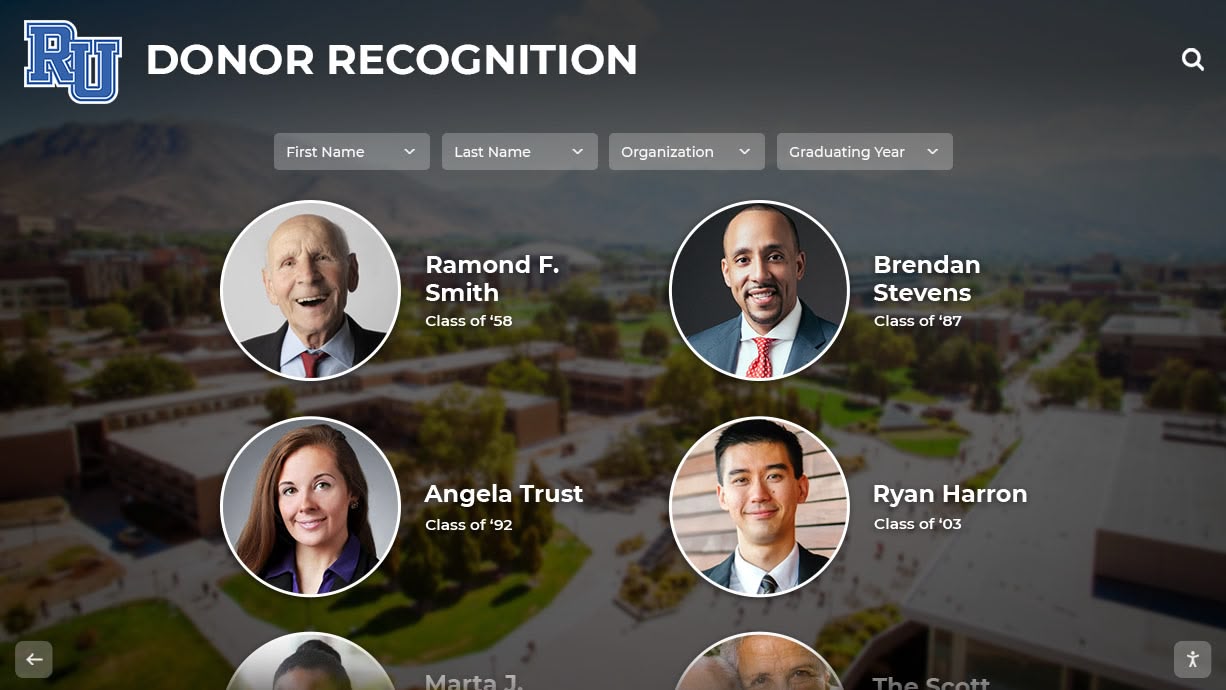
The Visibility Problem
Even when colleges invest significantly in traditional donor recognition, the impact remains limited. A beautiful donor wall in the main administration building reaches only the small percentage of supporters who physically visit campus—perhaps 5-10% of the donor base annually. The remaining 90-95% never see their recognition, eliminating the reinforcement value that drives continued engagement and giving.
Where Traditional Recognition Falls Short
Traditional donor recognition creates several barriers that actively undermine advancement objectives rather than supporting them.
Limited Stewardship Touchpoints
A donor’s name engraved on a plaque provides a single moment of acknowledgment. After the unveiling ceremony, there’s no mechanism for ongoing engagement, no way to update the story as impact unfolds, and no connection to the outcomes that contributions enabled. This one-time recognition fails to sustain the emotional connection that drives lifetime giving.
Space Constraints Forcing Difficult Decisions
Physical walls fill quickly, forcing advancement teams to establish minimum giving thresholds that exclude smaller donors or require expensive facility expansions. These limitations undermine inclusive recognition strategies and send unintended messages about which donors truly matter to the institution.
Update Complexity and Delays
Adding names to traditional displays requires vendor coordination, engraving production, and installation scheduling—processes consuming weeks or months. This friction discourages timely recognition and creates gaps between giving and acknowledgment that weaken the psychological reinforcement that strengthens donor relationships.
How Digital Recognition Transforms Donor Engagement
Modern digital recognition systems address these challenges comprehensively while creating new opportunities for meaningful donor stewardship that drives measurable advancement outcomes.
Immediate and Ongoing Recognition
Digital platforms enable advancement teams to acknowledge contributions within hours of gift processing rather than waiting weeks for plaque production. This immediacy capitalizes on donor motivation when it peaks, providing instant gratification that reinforces the positive emotions associated with giving.
Real-Time Recognition Benefits
When major donors visit campus days after making commitments and see their contributions already featured prominently in recognition displays, it powerfully reinforces that their gifts matter and are immediately valued by the institution. This responsiveness creates satisfaction that traditional approaches—with their months-long delays—cannot match.
Beyond initial acknowledgment, digital recognition creates ongoing visibility through regular content updates, featured donor spotlights, and impact story additions that keep recognition fresh and engaging. Donors who might view static plaques once during unveiling ceremonies return repeatedly to digital displays to see new content, creating multiple stewardship touchpoints from single recognition investments.
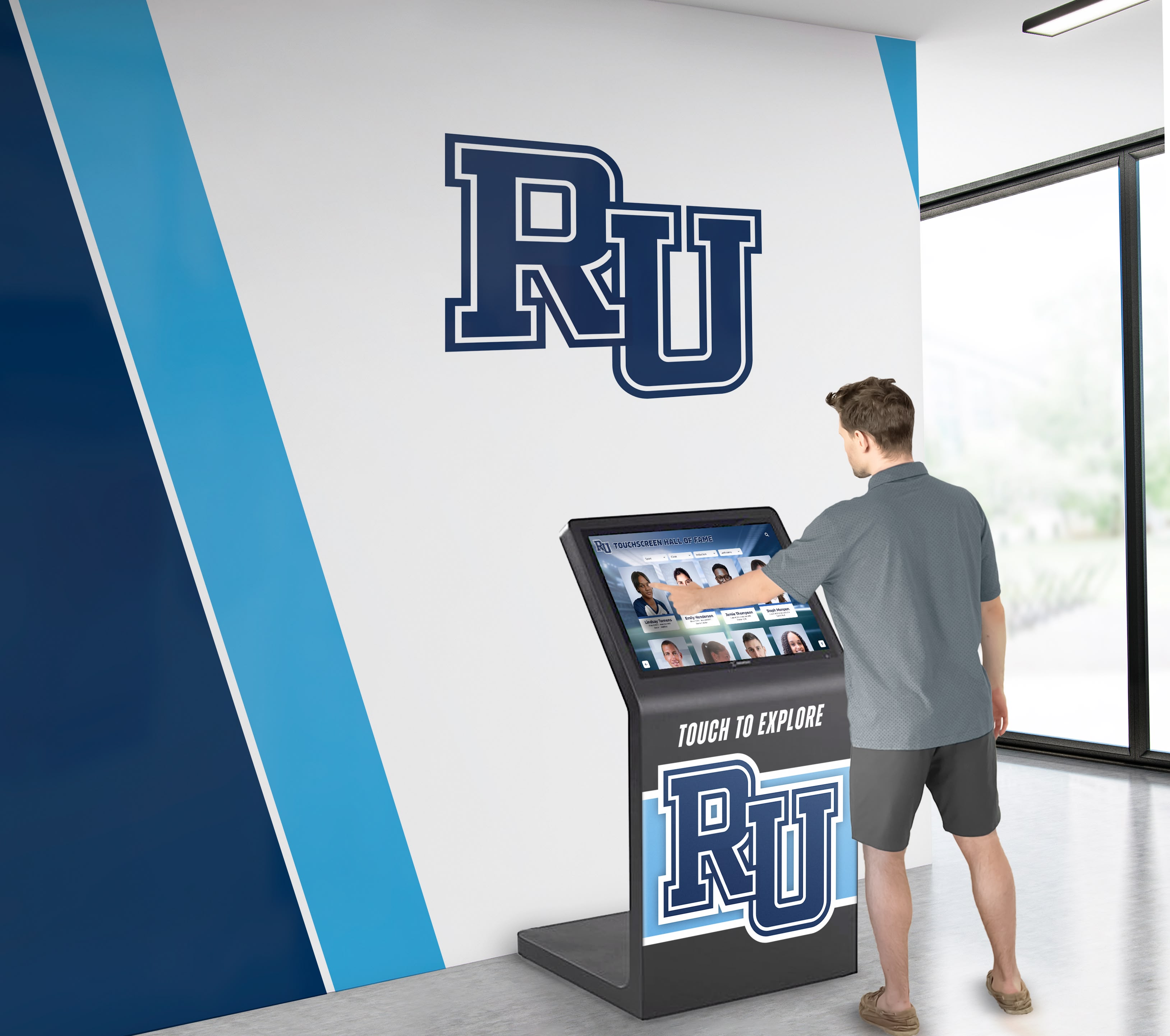
Unlimited Recognition Capacity
Digital systems accommodate unlimited donor profiles without physical constraints—whether recognizing 50 donors or 5,000, the footprint remains constant. This unlimited capacity enables truly comprehensive recognition that honors every contributor at every giving level without forcing difficult threshold decisions or expensive wall expansions.
Inclusive Recognition Structures
Solutions like Rocket Alumni Solutions enable advancement teams to create sophisticated recognition hierarchies that acknowledge all giving levels appropriately. Annual fund contributors who might never receive physical recognition due to space constraints can be honored through digital profiles alongside major gift donors—with visual distinctions that maintain appropriate prominence for leadership giving while ensuring all supporters feel valued.
This inclusive approach proves particularly valuable for comprehensive campaigns seeking broad participation. When donors at every level see meaningful recognition, participation rates increase as supporters understand that their contributions—regardless of size—matter to the institution.
Rich Multimedia Storytelling
Perhaps the most transformative capability of digital recognition is the ability to tell compelling donor stories that inspire others while honoring supporters through authentic narrative depth that brass plaques simply cannot provide.
Beyond Names and Numbers
Digital profiles can include high-resolution photos showing donors at events or with scholarship recipients, video testimonials explaining personal motivations for giving, written narratives sharing family connections spanning generations, impact statements demonstrating how specific gifts created change, and progress updates as multi-year projects supported by donations come to fruition.
This storytelling capability transforms recognition from simple acknowledgment into meaningful stewardship that creates emotional connections between donors and mission outcomes. When supporters see the faces of students their scholarships enabled or tour facilities their gifts made possible, abstract philanthropy becomes concrete impact that justifies continued investment.
Social Proof That Inspires Giving
Compelling donor stories serve dual purposes—honoring existing supporters while inspiring prospects considering their own contributions. When potential donors encounter authentic testimonials explaining why respected community members give, it normalizes charitable support as expected behavior among people they admire. This peer influence proves more persuasive than any institutional solicitation.
Organizations implementing digital displays that inspire alumni giving report that prospects frequently reference donor stories they discovered during campus visits as influencing factors in their own giving decisions—demonstrating recognition’s powerful role in acquisition beyond retention.
Strategic Benefits for College Advancement Programs
Digital donor recognition delivers measurable advantages across multiple advancement priorities, creating compounding value that extends far beyond simple acknowledgment.
Improved Donor Retention Rates
Small improvements in retention rates create enormous differences in lifetime donor value through compound effects across multiple giving cycles. Research consistently demonstrates that meaningful recognition significantly impacts retention, with organizations reporting 15-25% improvements following digital recognition implementation.
The Retention Mathematics
Consider two colleges with identical 100 new donors giving $1,000 annually. College A (traditional recognition) retains 40% of donors year-over-year—a typical rate for higher education. College B (comprehensive digital recognition) retains 60% annually. After five years, College A has 16 active donors while College B has 130—more than 8x difference. Over ten years, cumulative revenue gaps exceed $2 million from the same initial donor cohort.
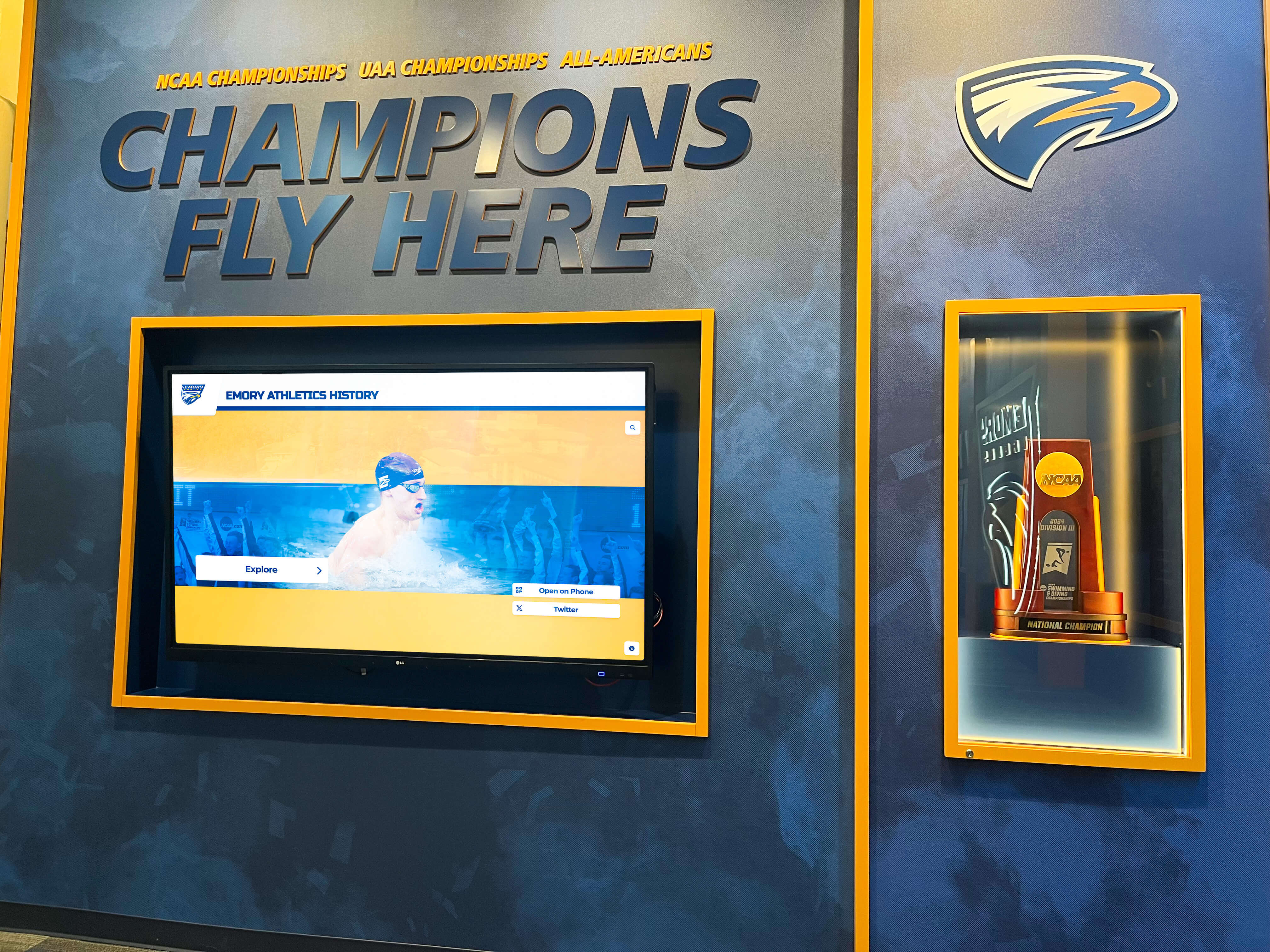
This retention improvement stems from multiple factors working together. Immediate recognition satisfies donors’ natural desire for acknowledgment when giving motivation peaks. Ongoing visibility ensures donors encounter their recognition regularly rather than experiencing one-time acknowledgment. Rich storytelling creates emotional connections that transcend transactional relationships. And measurable impact demonstration shows donors exactly how their contributions advanced institutional mission.
Enhanced Major Gift Cultivation
Development officers leveraging digital recognition displays report accelerated major gift timelines and increased gift sizes. Interactive displays serve as powerful cultivation tools during donor meetings and facility tours, providing compelling demonstrations of how institutions honor transformational contributions.
Prospect Engagement Strategies
Real-time demonstrations of recognition options allow gift officers to show prospects exactly how their contributions would be celebrated—moving beyond static mockups or verbal descriptions to interactive visualization that makes recognition tangible. Walk major donor prospects through actual display interfaces, explore similar donor profiles showing the depth of storytelling, and illustrate naming opportunities through live demonstrations that create clear vision of recognition benefits.
Flexible recognition structures accommodate complex gift arrangements common in major philanthropy. Digital systems easily handle multi-year pledges showing progress toward fulfillment, planned gifts acknowledging future commitments, family foundation giving crediting multiple generations, and cumulative lifetime giving that celebrates sustained support over decades. This flexibility proves particularly valuable when advancement teams need help managing sophisticated recognition programs that traditional plaques cannot accommodate.
Cultivation of Next-Generation Donors
Younger alumni particularly appreciate technology-enabled recognition aligning with their digital communication preferences. Millennial and Gen Z donors expect social sharing capabilities, mobile accessibility, and interactive engagement—all native to digital recognition systems but impossible with traditional plaques.
Digital-Native Engagement
Social media integration allows donors to share recognition easily across personal networks, creating organic advocacy that attracts peer donations. When donors photograph their digital profiles and post to Instagram, LinkedIn, or Facebook, they introduce institutional missions to hundreds of potential new supporters who trust peer recommendations more than official marketing.
Mobile accessibility extends recognition beyond physical locations. Donors access displays from anywhere via web portals and smartphone-optimized interfaces, maintaining engagement between campus visits. This constant accessibility keeps institutions top-of-mind while enabling long-distance donors to experience recognition comparable to local supporters who visit physical displays regularly.
Organizations implementing strategies for advancement help through digital recognition discover that technology enhances rather than diminishes personal connection when deployed thoughtfully—particularly with younger audiences who expect digital sophistication as baseline rather than luxury.
Implementing Effective Donor Recognition Programs
Successful digital recognition requires strategic planning that addresses both technical implementation and programmatic design ensuring recognition delivers intended advancement outcomes.
Defining Recognition Philosophy and Structure
Before selecting technology, advancement teams must establish clear recognition principles guiding program design and donor acknowledgment approaches.
Recognition Criteria and Thresholds
Determine which contributions warrant public recognition, establishing giving thresholds for various recognition tiers, approaches for handling anonymous giving preferences, policies for recognizing non-monetary contributions like volunteer service, and strategies for balancing current giving with cumulative lifetime support.
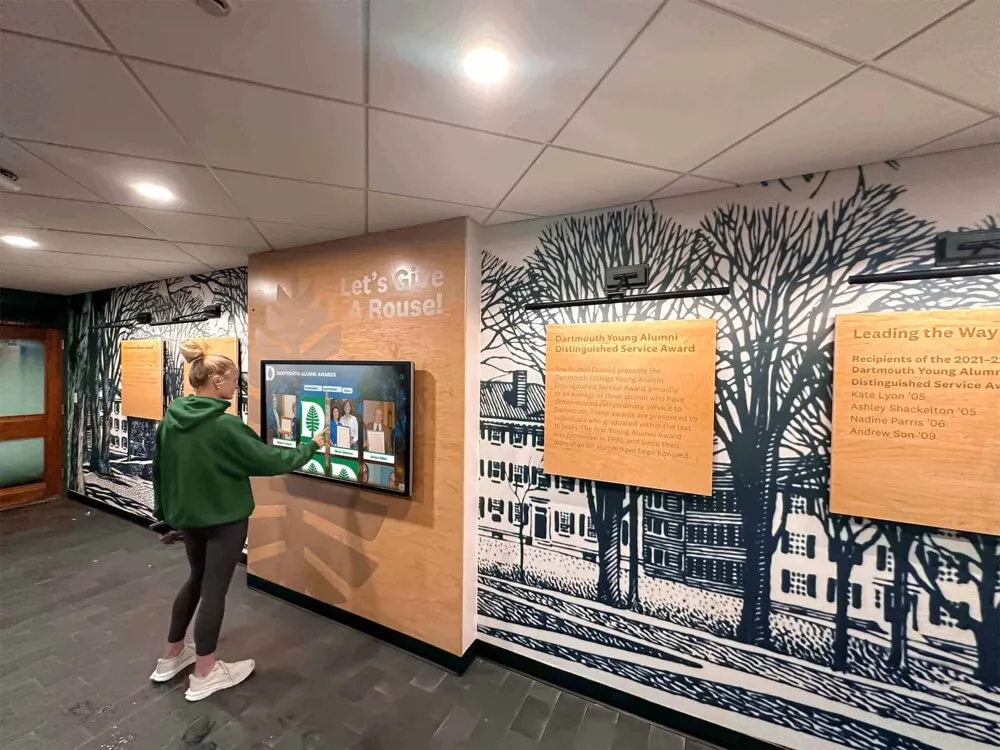
Effective recognition structures typically include multiple tiers acknowledging diverse giving capacities. Visionary Circle or Presidential Society members ($100,000+) receive premier recognition with extensive multimedia profiles and naming opportunities. Leadership Society supporters ($25,000-$99,999) enjoy enhanced recognition with photos, testimonials, and prominent positioning. Benefactor Circle contributors ($10,000-$24,999) receive featured profiles celebrating their significant support. Patron and Supporter levels ($1,000-$9,999) honor important annual fund donors through professional acknowledgment appropriate to their giving level.
This tiered approach provides clear upgrade pathways encouraging donors to increase giving over time while ensuring all supporters receive meaningful recognition regardless of contribution size.
Content Development That Inspires
Compelling recognition content forms the foundation of effective programs. Without interesting, well-crafted information, even sophisticated technology fails to engage visitors meaningfully or inspire continued giving.
Gathering Rich Donor Information
Develop systematic processes for collecting biographical information through donor surveys and interviews, giving histories from advancement databases, personal stories explaining motivations and institutional connections, high-quality photos from events or submitted by donors themselves, and video testimonials capturing authentic voices and emotions that written profiles cannot convey.
Many advancement teams initially worry about content volume, fearing they must achieve comprehensive coverage before launching. In practice, starting with 20-30 exceptional profiles of recent major donors, campaign leadership, and institutional legends proves more effective than attempting complete coverage with thin content. Launch with quality over quantity, then systematically expand recognition using established workflows and templates that accelerate profile development over time.
Quality Standards and Consistency
Establish standards ensuring all content meets minimum professional thresholds. Photo resolution requirements (minimum 2000 pixels wide), biographical narrative length guidelines (400-800 words providing substance without overwhelming), video production quality (HD resolution with clear audio), fact-checking processes ensuring accuracy, and privacy protocols respecting donor preferences about personal information visibility.
Template systems accelerate content creation while maintaining consistency. Rather than designing each profile from scratch, advancement staff populate template fields with appropriate information—reducing production time while ensuring professional presentation quality that reflects institutional excellence.
Technology Selection and Integration
Choose platforms specifically designed for advancement needs rather than general-purpose content management systems requiring extensive customization to serve recognition functions effectively.
Purpose-Built Recognition Platforms
Solutions like digital donor recognition displays from Rocket Alumni Solutions provide recognition-specific capabilities including donor tier management with flexible hierarchical structures, integrated giving history tracking, privacy controls respecting acknowledgment preferences, campaign progress visualization, and impact storytelling features—all designed specifically for advancement contexts rather than adapted from other purposes.
Generic website builders or content management systems lack these specialized features, requiring custom development that proves expensive, time-consuming, and difficult to maintain as institutional needs evolve. Purpose-built platforms deliver functionality advancement teams need immediately while providing ongoing enhancements addressing emerging best practices across higher education.
Database Integration Capabilities
Maximum value comes from integrating recognition platforms with existing advancement technology ecosystems. Evaluate systems offering connections to common CRM platforms like Raiser’s Edge, Blackbaud, or Salesforce, automated data synchronization keeping recognition current as donor information updates, single sign-on authentication simplifying administrative access, and comprehensive analytics combining recognition engagement with broader advancement metrics.
Integration eliminates duplicate data entry across multiple systems while ensuring single sources of truth for donor information. When supporters update contact details, make new gifts, or adjust recognition preferences, changes automatically propagate to all connected systems—maintaining accuracy without manual intervention that consumes staff time and introduces errors.
Best Practices for Maximizing Donor Engagement
Organizations achieving exceptional results with donor recognition follow proven practices that maximize both recognition effectiveness and fundraising outcomes.
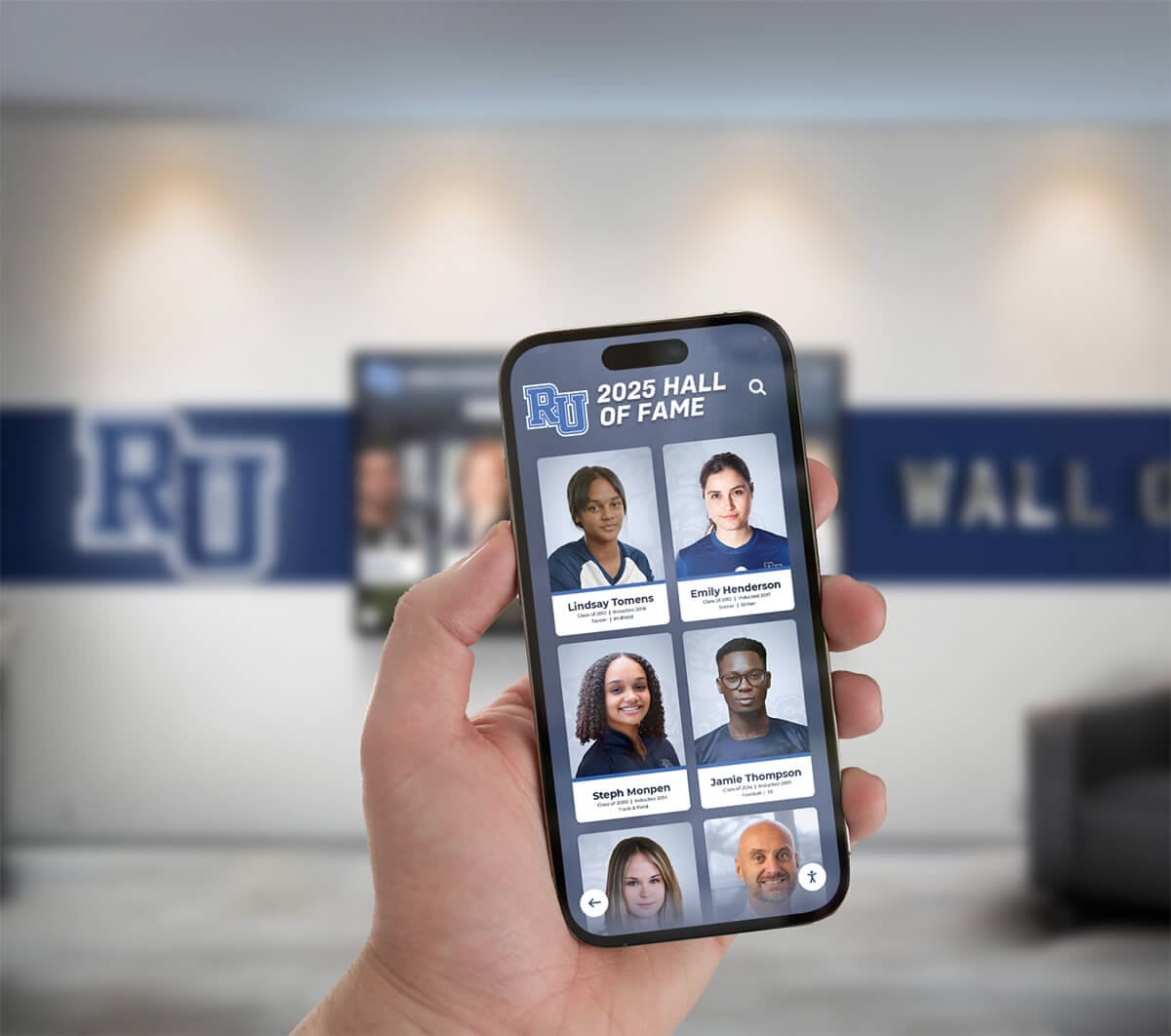
Multi-Channel Recognition Distribution
Physical displays create primary recognition experiences, but extending acknowledgment across multiple channels dramatically expands reach and engagement impact.
Online Recognition Portals
Web-accessible versions of recognition content allow worldwide alumni and supporters to explore donor profiles from anywhere, exponentially increasing recognition visibility beyond the small percentage visiting campus. Mobile-optimized interfaces ensure excellent smartphone experiences where most people consume digital content.
Social media integration provides donors satisfying acknowledgment they can distribute across networks, exposing institutions to new prospect audiences. Email campaign integration features recognition stories in stewardship communications, maintaining consistent donor touchpoints throughout the year.
This multi-channel distribution documented in online recognition best practices ensures acknowledgment reaches diverse audiences through their preferred platforms, maximizing engagement and fundraising impact.
Personalization and Donor Preferences
Not all donors want identical recognition approaches. Sophisticated programs accommodate diverse preferences while maintaining program coherence and professional presentation standards.
Respecting Privacy Choices
Provide clear options ranging from anonymous giving with no public acknowledgment, to minimal recognition showing only names, to standard profiles with basic information, and enhanced profiles featuring photos, testimonials, and detailed stories. Consistently respect these preferences across all recognition channels, building trust that strengthens donor relationships.
Some major donors prefer understated acknowledgment despite significant contributions, while others embrace prominent recognition as platform for encouraging peers toward similar generosity. Neither approach is wrong—what matters is honoring individual preferences that reflect personal values and circumstances.
Regular Content Updates and Refresh
Sustained engagement requires strategic content refresh ensuring recognition remains dynamic rather than becoming stale museum exhibit that visitors ignore.
Content Update Strategies
Implement predictable cycles adding new donors quarterly following campaign deadlines or fiscal periods. Rotate featured content monthly through homepage spotlights, email campaign highlights, and social media features. Progressively enhance existing profiles where initial basic recognition gains additional depth over time—recent interviews added to historical profiles, career updates as donors achieve new milestones, or newly discovered archival photos enriching earlier thin content.
Event-aligned recognition spotlights relevant donors during homecoming celebrations, reunion weekends, or campaign milestone events. Themed content collections organize recognition around timely topics—scholarship donors featured during commencement, athletic supporters highlighted during championship celebrations, or research supporters showcased when breakthroughs occur.
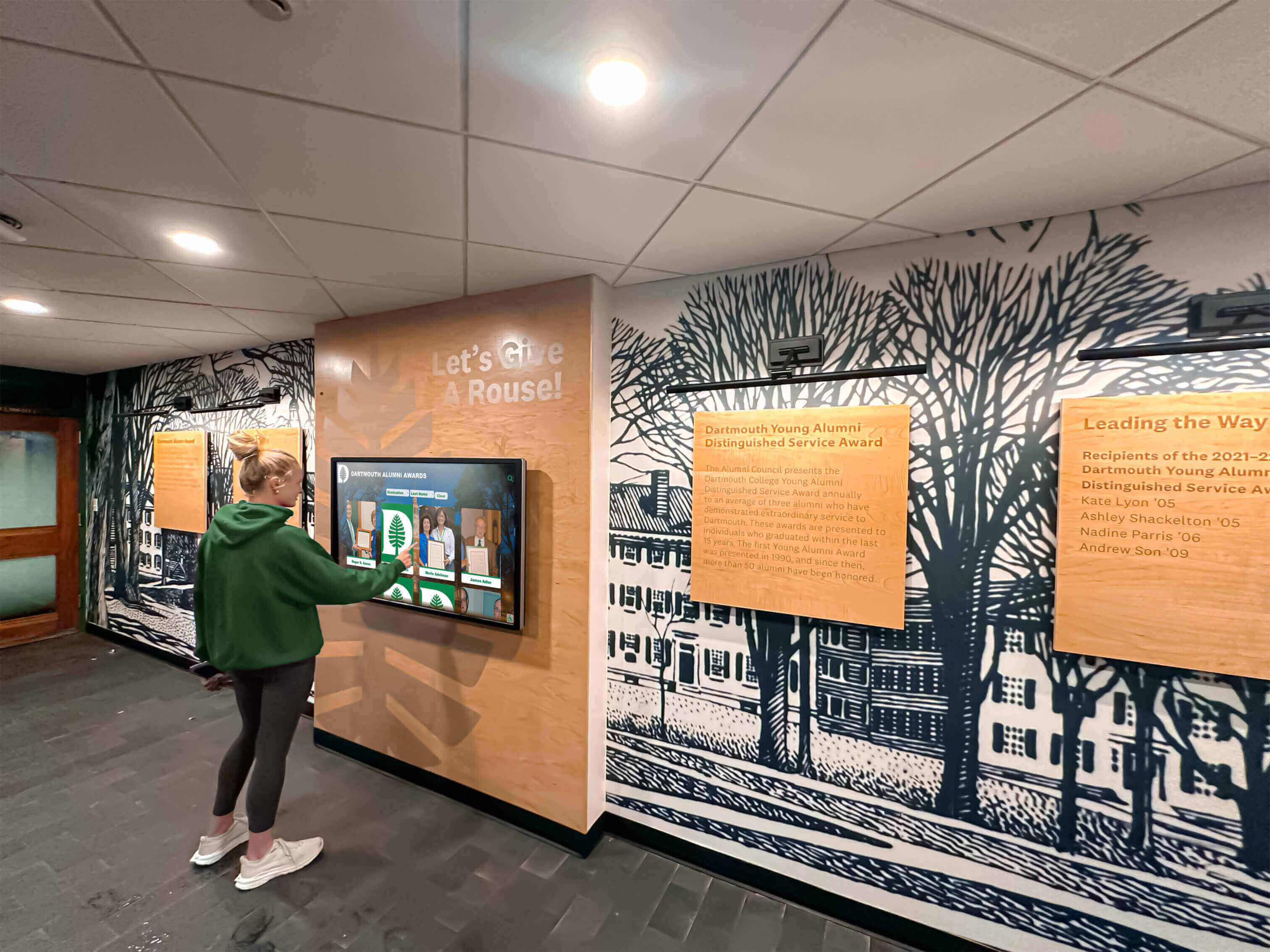
Organizations treating recognition as living program rather than static installation maintain significantly higher ongoing engagement than those launching initial content that then stagnates. Fresh content provides reasons for repeat visits while demonstrating institutional commitment to honoring supporters meaningfully.
Measuring Recognition Impact on Fundraising Outcomes
Strategic advancement teams track recognition effectiveness through quantitative metrics and qualitative feedback informing continuous improvement and demonstrating return on investment.
Donor Behavior Metrics
Connect recognition exposure to giving behavior by comparing retention rates for recognized versus unrecognized donors (typically 15-25 percentage point improvements), tracking average gift size trends for donors receiving recognition, measuring upgrade conversion rates across recognition tiers, monitoring time-to-next-gift for recognized donors, and analyzing planned giving inquiry correlations with recognition program visibility.
While isolating causation proves challenging given multiple simultaneous advancement initiatives, institutions consistently observe these improvements following recognition platform implementations—creating strong evidence of positive impact on fundraising outcomes.
Engagement Analytics
Interactive platforms provide detailed metrics about visitor behavior impossible with traditional recognition approaches. Track unique visitor counts revealing overall reach and awareness, session duration indicating engagement depth (organizations typically see 6-8 minute average interactions compared to 30-60 seconds for static displays), pages per session showing exploration breadth, return visitor rates demonstrating sustained interest, and peak usage patterns informing optimal timing for updates and promotions.
Content performance intelligence reveals which profiles, stories, and categories generate most engagement—informing future content priorities and helping advancement teams optimize recognition for maximum impact. When certain donor stories receive consistently high engagement, it signals effective approaches worth replicating. When content categories show low interaction, teams can adjust presentation or emphasis.
Calculating Lifetime Donor Value Impact
The most significant financial impact appears in improved lifetime donor value resulting from better retention and upgrade rates that compound across decades of giving.
Lifetime Value Calculation Framework
Average Lifetime Donor Value = (Average Annual Gift × Average Donor Lifespan) + Probability of Major Gift
Recognition programs increase lifetime value through all components—higher average annual gifts (15-20% improvements commonly reported), extended donor lifespans via improved retention (20-25 percentage point improvements often doubling average lifespan), and increased probability of major or planned gifts (donors with strong recognition-driven connections give transformational gifts at 3x rates of less-engaged supporters).
Small improvements compound dramatically. A donor giving $1,000 annually with 40% year-over-year retention has projected lifetime value of $2,500. That same donor with 60% retention—a 20-point improvement typical of strong recognition programs—has projected lifetime value of $6,667, representing 167% increase from the retention improvement alone before considering average gift size increases or major gift probability improvements.
Common Implementation Challenges and Solutions
Organizations implementing donor recognition encounter predictable obstacles. Understanding challenges and proven solutions helps ensure successful programs delivering intended advancement outcomes.
Challenge: Budget Constraints
Comprehensive recognition programs require initial investment that may challenge institutions with limited resources or competing priorities.
Solutions and Funding Approaches
Implement phased approaches starting with single display in highest-priority location (main administration building or advancement office), proving value before expanding. Calculate total cost of ownership comparing digital systems to ongoing traditional recognition expenses over 10-year periods—most institutions discover positive ROI within 3-5 years while gaining capabilities traditional approaches never provide.
Pursue dedicated fundraising specifically for recognition infrastructure, positioning system itself as recognition opportunity. Some institutions secure lead gifts from donors who fund recognition displays honoring their peers, creating self-funding programs. Consider recognition system costs as legitimate campaign expenses supporting donor stewardship essential to campaign success.
Challenge: Content Development Capacity
Teams wonder whether they have capacity to populate and maintain recognition platforms given existing workload pressures.
Practical Content Approaches
Start with smaller initial set focusing on recent, well-documented donors rather than attempting comprehensive historical coverage before launch. Engage student workers or volunteers for research and content development, spreading workload beyond core advancement staff. Implement standardized templates simplifying ongoing additions once processes are established.
Many institutions discover that content maintenance requires less ongoing effort than traditional recognition coordination—updates take minutes rather than weeks while delivering significantly enhanced stewardship value. The time investment shifts from vendor coordination and physical installation to content creation that advancement teams control directly.
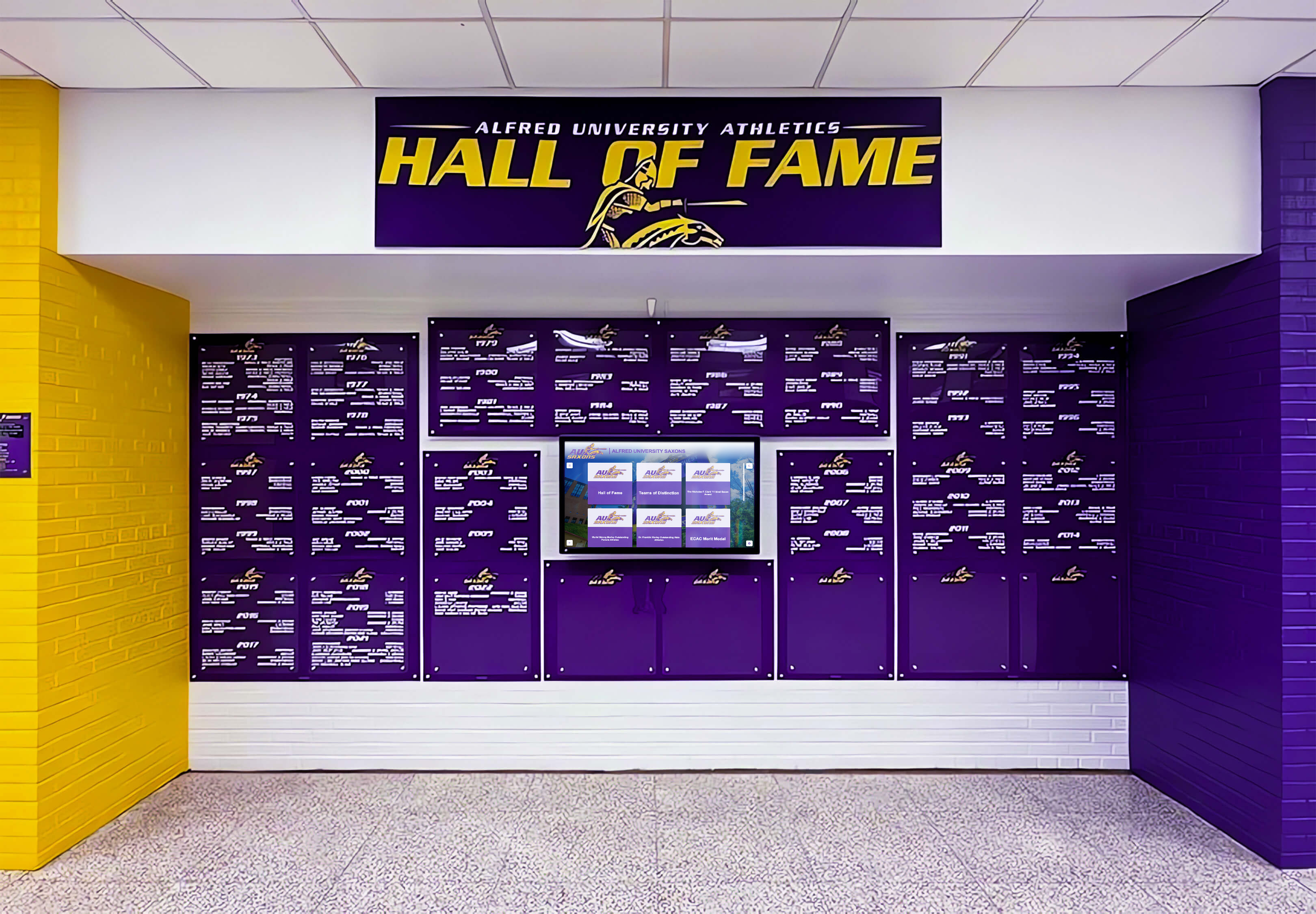
Challenge: Technology Concerns
Non-technical advancement professionals may worry about system complexity and ongoing management requirements, particularly in understaffed offices.
User-Friendly Solutions
Modern platforms prioritize intuitive interfaces requiring no technical expertise—managing recognition becomes comparable to updating social media profiles. Cloud-based systems eliminate server maintenance and technical infrastructure requirements, with vendors handling all backend technology while advancement teams focus solely on content.
Comprehensive training during implementation, responsive support for troubleshooting questions, automatic updates requiring no IT involvement, and mobile-friendly management accessible from any device address technical concerns. Purpose-built advancement platforms recognize that development professionals need tools that just work rather than systems requiring technical expertise to operate effectively.
Integration with Comprehensive Advancement Strategy
Digital donor recognition delivers maximum value when integrated strategically within holistic advancement operations rather than deployed as isolated technology project.
Campaign Integration
Design recognition components before launching capital campaigns so leadership prospects understand exactly what acknowledgment their contributions will receive. Use premier recognition opportunities as compelling incentives for leadership gifts setting campaign momentum. Structure accessible recognition tiers encouraging broad participation across all donor capacity levels.
Deploy real-time campaign progress displays building excitement and urgency, showing gifts received during events and creating momentum that encourages additional spontaneous commitments. Feature campaign-specific content highlighting priority initiatives and demonstrating how contributions advance specific strategic objectives.
Event Programming Integration
Position recognition displays prominently at major advancement events including homecoming celebrations, reunion weekends, and donor appreciation galas. Create programming around recognition unveilings and induction ceremonies that drive event attendance. Use displays as information centers during large gatherings, providing engagement opportunities that create memorable experiences.
Capture event photos and testimonials for addition to recognition displays, creating permanent documentation of community celebrations while providing content that extends event impact beyond program dates.
Alumni Relations Coordination
When donor recognition systems integrate with broader alumni engagement strategies, institutions create comprehensive ecosystems celebrating all forms of community participation. Alumni see achievements honored alongside philanthropic support, creating holistic recognition that strengthens institutional connections through multiple identity dimensions simultaneously.
Cross-referencing recognition systems reveals cultivation opportunities by identifying accomplished alumni who haven’t yet become donors—prospects worthy of development outreach based on capacity indicators and institutional affinity demonstrated through other engagement.
Conclusion: Recognition as Strategic Fundraising Infrastructure
Digital donor recognition represents far more than upgraded plaques—it functions as strategic fundraising infrastructure creating experiences that strengthen donor bonds, generating insights informing advancement strategy, supporting cultivation through demonstrated stewardship practices, and building institutional pride benefiting entire communities.
Colleges implementing comprehensive digital recognition consistently report significant financial returns exceeding system costs: 15-25% improvements in donor retention during first years, 20-30% increases in average gift sizes, measurable ROI within 18-24 months through enhanced giving patterns, and sustained improvements compounding across decades as recognition programs mature and donor relationships deepen.
Keys to Recognition-Driven Advancement Success:
- Start with clear objectives connecting recognition to broader institutional advancement priorities and campaign goals
- Invest in quality content development telling compelling stories rather than simply listing names and amounts
- Select technology platforms matching institutional capacity and long-term strategic needs
- Promote recognition consistently rather than relying solely on initial launch enthusiasm
- Measure engagement systematically enabling continuous improvement based on actual results rather than assumptions
- Integrate recognition throughout advancement programming rather than treating as standalone initiative
- Plan for sustainability through adequate budget, staffing, and processes supporting ongoing program vitality
The most successful colleges recognize that donor recognition represents institutional priority worthy of strategic investment in platforms serving stewardship missions effectively while adapting to evolving digital expectations. Digital recognition displays created through thoughtful planning, quality content, and strategic integration create powerful advancement tools generating compounding returns that support institutional missions across generations.
As competition for philanthropic support intensifies and donor expectations continue evolving, colleges that embrace modern recognition technology position themselves for sustained advancement success. The question facing higher education advancement leaders is not whether digital recognition belongs in their stewardship portfolio, but how quickly they’ll implement solutions delivering the engagement and giving improvements their institutions need.
Ready to transform your college’s donor recognition and advancement outcomes? Explore how solutions like Rocket Alumni Solutions provide comprehensive platforms, professional implementation support, and proven best practices ensuring recognition excellence without requiring extensive technical expertise or internal resources. The future of higher education advancement combines the emotional power of meaningful recognition with the capabilities of modern technology—creating experiences that honor generous supporters while inspiring the continued philanthropy that sustains institutional excellence and mission advancement for decades to come.




































